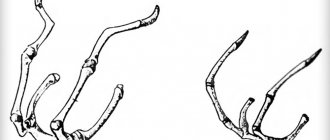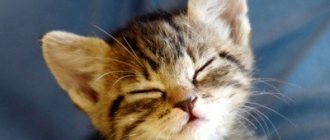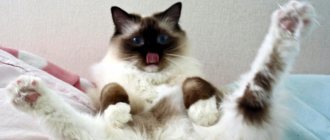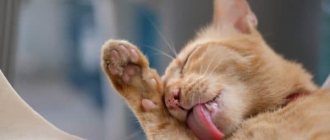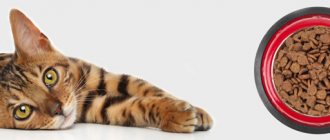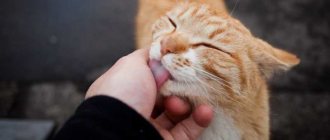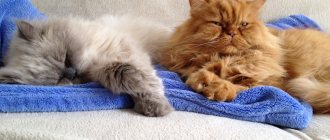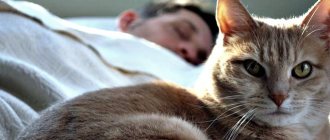A cat's purring is considered one of the most pleasant sounds for human ears, along with the singing of birds, the sound of rain, and the crackling of firewood. Measured vibrating sounds calm the nervous system and promote relaxation. Scientists have figured out why cats purr and were able to explain it from a physics point of view. They were able to determine not only the cause, but also highlight the sound features.
Sound mechanism
It is known that the volume and frequency of purring directly depends on the emotional state of the pet. Scientists have differing opinions about how cats make these sounds:
- Using vibrations of the false vocal cords . Animals use their regular vocal cords when they meow. Cats purr with their mouths closed, while special bones located under the root of the tongue vibrate, and a person hears a pleasant sound, reminiscent of a quietly working tractor.
- Involving the sinuses . It is believed that when the state of the nervous system changes, blood pressure changes. This causes the sternum to vibrate. The waves pass into the air cavities of the skull, where they are converted into sound. Large felines have thicker sinuses, protected by dense cartilage tissue, so only domestic cats and their relatives with the same parameters can purr.
- Sound production in the lungs . Purring occurs in time with the inhalation and exhalation of air, while the diaphragmatic and intercostal muscles are actively involved, which allows you to obtain sound vibrations with different amplitudes.
What is purring like?
Purrs vary in volume and duration of sound. If a cat makes a loud noise, it could signal problems or negative emotions, such as being unhappy or scared.
Loud and short-lived purring can be a sign of hunger. If the loud purring does not stop for a long time, there is a possibility that the animal is in pain.
When a cat is relaxed and calm, it makes a quiet and soft sound. In this case, the purring lasts a long time.
Causes of rumbling
Watching your pet, you may notice that the cat purrs in certain situations. There are several main causes of purring.
Communication and self-soothing
- Communication between mother and cubs . Animals maintain contact with their offspring, not being afraid to attract enemies with loud sounds. If a kitten purrs, its mother understands that the baby is healthy and eating well. The cat's response signals reassure the cubs, explaining that they are safe and can rest peacefully. In the wild, the female has to leave the nest for a while to hunt. She hears the quiet vibration emitted by the brood from a distance, unlike predators who react mainly to squeaks.
- Feeding on mother's milk . In this case, purring means pleasure and an expression of gratitude. Sometimes a nursing mother purrs, encouraging timid babies.
- Self-soothing . Vibration performed at a certain frequency allows the animal to reduce blood pressure, which can reach critical levels when excited and stressed. The pulse normalizes, the activity of the nervous system improves. While purring, the cat is in a state that can be compared to nirvana - attention is directed inward, the body is relaxed, and the consciousness is detached from the outside world. Some animals purr to quickly get used to a new environment or to more easily endure transportation or a visit to the veterinarian.
- Preparation for sleep . Sound vibrations set your pet up for rest, promote relaxation and allow you not to be distracted by external stimuli. The purring cat is sleeping soundly and feeling well.
Expressing emotions
- Gratitude . If the owner pets his pet and treats it with a treat, the animal can express its pleasure and affection for the owner.
- The joy of meeting . Animals often purr after meeting their owner, especially if it was preceded by a long separation. Such a greeting signals a friendly attitude and joy; it can be intended not only for a person, but also for a relative.
- Request . Sometimes the cat begs the owner for a treat in this way.
- Negative reaction . A frightened animal may also rumble.
Maintaining Health
Muscle training . It is believed that thanks to the sounds produced, the cat maintains tone of the diaphragm, ligamentous apparatus and intercostal muscles.
Such exercise does not allow tissues to atrophy, despite the fact that pets spend most of the day sleeping and devote little time to active games.
Staying healthy . Experts have noted that animals that have undergone surgery often purr. The sounds produced help improve metabolism, relieve pain and stimulate tissue regeneration. Many scientists are sure that being near a purring pet brings benefits to a person. Vibrations reduce the likelihood of pathologies of the nervous and cardiovascular systems in animal owners.
The variety of factors to which cats respond by purring confirms that in this way pets interact with the outside world and restore their nervous system.
How cats purr
This is the simplest question, the answer to which scientists have more or less figured out.
Why and how do cats purr / Library of Congress is assumed that the purring sound is produced by the internal muscles of the larynx. They cause the glottis to contract and expand rhythmically. Therefore, during inhalation and exhalation, as the air passes through the larynx, it vibrates Why do cats purr / Scientific American in the frequency range from 25 to 150 Hz - this is how a soft ri is created. But why the muscles of the larynx begin to work in purring mode and what the cat actually wants to say with its purring is not yet entirely clear.
Currently reading
